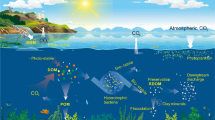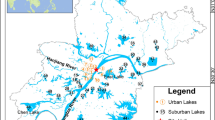Abstract
Lake waters often act as important methane sources for global greenhouse gas emission, but it would be more complex as lakes are regulated by rivers. In this study, seasonal variations of dissolved and emitted methane in the Poyang Lake, the largest freshwater lake in China, are investigated based on a specially designed monitoring. As a typical subtropical linking-to-river lake, the Poyang shows characteristics of the “lake” in wet season and the “river” in dry season alternatively over a year. Consequently, CH4 flux from the Poyang Lake to the Yangtze River closes to the highest in January due to concentrated dissolved CH4 and “river” effects in dry season, while CH4 flux to the atmosphere falls to the lowest in July because of intensified CH4 oxidization and diluted dissolved CH4 as well as “lake” effects in wet season. Overall, CH4 fluxes from Poyang Lake to the atmosphere and to the Yangtze River were 19 and 0.35 Gg CH4 yr−1, respectively. The Three Gorges Dam, the world’s largest dam in the Yangtze River, would further intensify this pattern, enhancing the transformation between “lake phase” and “river phase”. This study also provides the paradigm for CH4 budget from other large lakes in similar situations around the world.
Similar content being viewed by others
References
Stocker T, Alexander L, Allen M, et al. IPCC. Working Group I Contribution to the IPCC Fifth Assessment Report (AR5). Climate Change 2013: The Physical Science Basis. Final Draft Underlying Scientific-Technical Assessment. Cambridge: Cambridge University Press, 2013
Kirschke S, Bousquet P, Ciais P, et al. Three decades of global methane sources and sinks. Nat Geosci, 2013, 6: 813–823
Betts R A, Jones C D, Knight J R, et al. El Niño and a record CO2 rise. Nat Clim Change, 2016, 6: 806–810
Le Quéré C, Moriarty R, Andrew R M, et al. Global carbon budget 2015. Earth Syst Sci Data, 2015, 7: 349–396
Bastviken D, Cole J, Pace M, et al. Methane emissions from lakes: Dependence of lake characteristics, two regional assessments, and a global estimate. Glob Biogeochem Cycle, 2004, 18: GB4009
Tranvik L J, Downing J A, Cotner J B, et al. Lakes and reservoirs as regulators of carbon cycling and climate. Limnol Oceanogr, 2009, 54: 2298–2314
Mei X, Dai Z, Du J, et al. Linkage between Three Gorges Dam impacts and the dramatic recessions in China’s largest freshwater lake, Poyang Lake. Sci Rep, 2015, 5: 18197
Raymond P A, Hartmann J, Lauerwald R, et al. Global carbon dioxide emissions from inland waters. Nature, 2013, 503: 355–359
Bastviken D, Tranvik L J, Downing J A, et al. Freshwater methane emissions offset the continental carbon sink. Science, 2011, 331: 50
Barros N, Cole J J, Tranvik L J, et al. Carbon emission from hydroelectric reservoirs linked to reservoir age and latitude. Nat Geosci, 2011, 4: 593–596
Xing Y, Xie P, Yang H, et al. Methane and carbon dioxide fluxes from a shallow hypereutrophic subtropical Lake in China. Atmos Environ, 2005, 39: 5532–5540
Wu Z, Lai X, Zhang L, et al. Phytoplankton chlorophyll a in Lake Poyang and its tributaries during dry, mid-dry and wet seasons: A 4-year study. Knowl Managt Aquat Ecosyst, 2014, 412: 06
Lai X, Huang Q, Zhang Y, et al. Impact of lake inflow and the Yangtze River flow alterations on water levels in Poyang Lake, China. Lake Reservoir Manage, 2014, 30: 321–330
Zhang Q, Ye X, Werner A D, et al. An investigation of enhanced recessions in Poyang Lake: Comparison of Yangtze River and local catchment impacts. J Hydrol, 2014, 517: 425–434
Wu N, Liu Y, Liu T, et al. Experimental study on the effect of the Three Gorges Project on water level in Lake Poyang. J Lake Sci, 2014, 26: 522–528
Zhang Y, Yang G, Li B, et al. Using eutrophication and ecological indicators to assess ecosystem condition in Poyang Lake, a Yangtze-connected lake. Aquat Ecosyst Health Manage, 2016, 19: 29–39
Shankman D, Keim B D, Song J. Flood frequency in China’s Poyang Lake region: Trends and teleconnections. Int J Climatol, 2006, 26: 1255–1266
Wang S M, Dou H E A. Chinese Lakes (in Chinese). Beijing: Science Press, 1998
Beaulieu J J, Shuster W D, Rebholz J A. Nitrous oxide emissions from a large, impounded river: The Ohio River. Environ Sci Technol, 2010, 44: 7527–7533
Beaulieu J J, Smolenski R L, Nietch C T, et al. High methane emissions from a midlatitude reservoir draining an agricultural watershed. Environ Sci Technol, 2014, 48: 11100–11108
Ran L, Lu X X, Richey J E, et al. Long-term spatial and temporal variation of CO2 partial pressure in the Yellow River, China. Biogeosciences, 2015, 12: 921–932
Chen Y, Bai X, Li X, et al. A primary study of the methane flux on the water-air interface of eight lakes in winter, China. J Lake Sci, 2007, 19: 11–17
Raymond P A, Cole J J. Gas exchange in rivers and estuaries: Choosing a gas transfer velocity. Estuaries, 2001, 24: 312–317
Wanninkhof R. Relationship between wind speed and gas exchange over the ocean revisited. Limnol Oceanogr Methods, 2014, 12: 351–362
Richey J E, Melack J M, Aufdenkampe A K, et al. Outgassing from Amazonian rivers and wetlands as a large tropical source of atmospheric CO2. Nature, 2002, 416: 617–620
Huttunen J T, Alm J, Liikanen A, et al. Fluxes of methane, carbon dioxide and nitrous oxide in boreal lakes and potential anthropogenic effects on the aquatic greenhouse gas emissions. Chemosphere, 2003, 52: 609–621
Beaulieu J J, Tank J L, Hamilton S K, et al. Nitrous oxide emission from denitrification in stream and river networks. Proc Natl Acad Sci USA, 2011, 108: 214–219
Podgrajsek E, Sahlée E, Rutgersson A. Diurnal cycle of lake methane flux. J Geophys Res Biogeosci, 2014, 119: 236–248
Liu T, Zhang A N, Wang J, et al. Integrated biogeography of planktonic and sedimentary bacterial communities in the Yangtze River. Microbiome, 2018, 6: 16
Dumestre J F, Guezennec J, Galy-Lacaux C, et al. Influence of light intensity on methanotrophic bacterial activity in Petit Saut Reservoir, French Guiana. Appl Environ Microbiol, 1999, 65: 534–539
Natchimuthu S, Panneer Selvam B, Bastviken D. Influence of weather variables on methane and carbon dioxide flux from a shallow pond. Biogeochemistry, 2014, 119: 403–413
Duan X, Wang X, Mu Y, et al. Seasonal and diurnal variations in methane emissions from Wuliangsu Lake in arid regions of China. Atmos Environ, 2015, 39: 4479–4487
Tang K W, McGinnis D F, Frindte K, et al. Paradox reconsidered: Methane oversaturation in well-oxygenated lake waters. Limnol Oceanogr, 2014, 59: 275–284
Borges A V, Abril G, Delille B, et al. Diffusive methane emissions to the atmosphere from Lake Kivu (Eastern Africa). J Geophys Res, 2011, 116: G03032
Borges A V, Darchambeau F, Lambert T, et al. Effects of agricultural land use on fluvial carbon dioxide, methane and nitrous oxide concentrations in a large European river, the Meuse (Belgium). Sci Total Environ, 2018, 610–611: 342–355
Zhao Y, Wu B F, Zeng Y. Spatial and temporal patterns of greenhouse gas emissions from Three Gorges Reservoir of China. Biogeosciences, 2013, 10: 1219–1230
Sepulveda-Jauregui A, Hoyos-Santillan J, Martinez-Cruz K, et al. Eutrophication exacerbates the impact of climate warming on lake methane emission. Sci Total Environ, 2018, 636: 411–419
Bastviken D, Cole J J, Pace M L, et al. Fates of methane from different lake habitats: Connecting whole-lake budgets and CH4 emissions. J Geophys Res, 2008, 113: G02024
Søndergaard M, Kristensen P, Jeppesen E. Phosphorus release from resuspended sediment in the shallow and wind-exposed Lake Arresø, Denmark. Hydrobiologia, 1992, 228: 91–99
Wu Z, Zhang D, Cai Y, et al. Water quality assessment based on the water quality index method in Lake Poyang: The largest freshwater lake in China. Sci Rep, 2017, 7: 17999
Cao J, Chu Z, Du Y, et al. Phytoplankton dynamics and their relationship with environmental variables of Lake Poyang. Hydrol Res, 2016, 47: 249–260
Borges A V, Darchambeau F, Lambert T, et al. Variations in dissolved greenhouse gases (CO2, CH4, N2O) in the Congo River network overwhelmingly driven by fluvial-wetland connectivity. Biogeosciences, 2019, 16: 3801–3834
Martens C S, Val Klump J. Biogeochemical cycling in an organic-rich coastal marine basin 4. An organic carbon budget for sediments dominated by sulfate reduction and methanogenesis. Geochim Cosmochim Acta, 1984, 48: 1987–2004
Ostrovsky I, McGinnis D F, Lapidus L, et al. Quantifying gas ebullition with echosounder: The role of methane transport by bubbles in a medium-sized lake. Limnol Oceanogr Methods, 2008, 6: 105–118
Wik M, Crill P M, Varner R K, et al. Multiyear measurements of ebullitive methane flux from three subarctic lakes. J Geophys Res Biogeosci, 2013, 118: 1307–1321
Zhang B, Jiang Y, Zuo K, et al. Microbial vanadate and nitrate reductions coupled with anaerobic methane oxidation in groundwater. J Hazard Mater, 2020, 382: 121228
Yvon-Durocher G, Allen A P, Bastviken D, et al. Methane fluxes show consistent temperature dependence across microbial to ecosystem scales. Nature, 2014, 507: 488–491
Westermann P, Ahring B K, Mah R A. Temperature compensation in Methanosarcina barkeri by modulation of hydrogen and acetate affinity. Appl Environ MicroBiol, 1989, 55: 1262–1266
Borges A V, Darchambeau F, Teodoru C R, et al. Globally significant greenhouse-gas emissions from African inland waters. Nat Geosci, 2015, 8: 637–642
Borges A V, Abril G, Darchambeau F, et al. Divergent biophysical controls of aquatic CO2 and CH4 in the World’s two largest rivers. Sci Rep, 2015, 5: 15614
Bastviken D, Santoro A L, Marotta H, et al. Methane emissions from Pantanal, South America, during the low water season: Toward more comprehensive sampling. Environ Sci Technol, 2010, 44: 5450–5455
Purvaja R, Ramesh R. Human impacts on methane emission from mangrove ecosystems in India. Reg Environ Change, 2000, 1: 86–97
Verma A, Subramanian V, Ramesh R. Methane emissions from a coastal lagoon: Vembanad Lake, West Coast, India. Chemosphere, 2002, 47: 883–889
Lin M. Greenhouse gas fluxes on the water-air interface of Poyang Lake (in Chinese). Dissertation for Master’s Degree. Beijing: Beijing Forestry University, 2012
Marinho C C, Palma Silva C, Albertoni E F, et al. Seasonal dynamics of methane in the water column of two subtropical lakes differing in trophic status. Braz J Biol, 2009, 69: 281–287
Pavel A, Durisch-Kaiser E, Balan S, et al. Sources and emission of greenhouse gases in Danube Delta lakes. Environ Sci Pollut Res, 2009, 16: 86–91
Musenze R S, Grinham A, Werner U, et al. Assessing the spatial and temporal variability of diffusive methane and nitrous oxide emissions from subtropical freshwater reservoirs. Environ Sci Technol, 2014, 48: 14499–14507
Soja G, Kitzler B, Soja A M. Emissions of greenhouse gases from Lake Neusiedl, a shallow steppe lake in Eastern Austria. Hydrobiologia, 2014, 731: 125–138
Hu M L. Characteristics of water level, water environment and effects on fish communication and migration in the Hukou area of Poyang Lake (in Chinese). Dissertation for Master’s Degree. Nanchang: Nanchang University, 2009
Liu F, Zhang X, Fan J Y, et al. Improvement of the model of the relationship between Poyang Lake water area and estuary water level (in Chinese). Meteorol Disast Reduct Res, 2011, 34: 45–49
Li S, Bush R T, Santos I R, et al. Large greenhouse gases emissions from China’s lakes and reservoirs. Water Res, 2018, 147: 13–24
Chen H, Yuan X, Chen Z, et al. Methane emissions from the surface of the Three Gorges Reservoir. J Geophys Res, 2011, 116: D21306
Author information
Authors and Affiliations
Corresponding author
Additional information
This work was supported by the National Natural Science Foundation of China (Grant No. 51539001).
Rights and permissions
About this article
Cite this article
Wang, H., Huang, R., Li, J. et al. Dissolved and emitted methane in the Poyang Lake. Sci. China Technol. Sci. 64, 203–212 (2021). https://doi.org/10.1007/s11431-020-1594-6
Received:
Accepted:
Published:
Issue Date:
DOI: https://doi.org/10.1007/s11431-020-1594-6




